Herb Gardening Tips for Utah: Essential Advice for Thriving Herbs in Arid Climates
Herb gardening in Utah means dealing with the state’s quirky climate and soil. If you want healthy herbs, you’ll need to pick plants that can handle hot, dry summers and chilly winters—and get strategic about water.
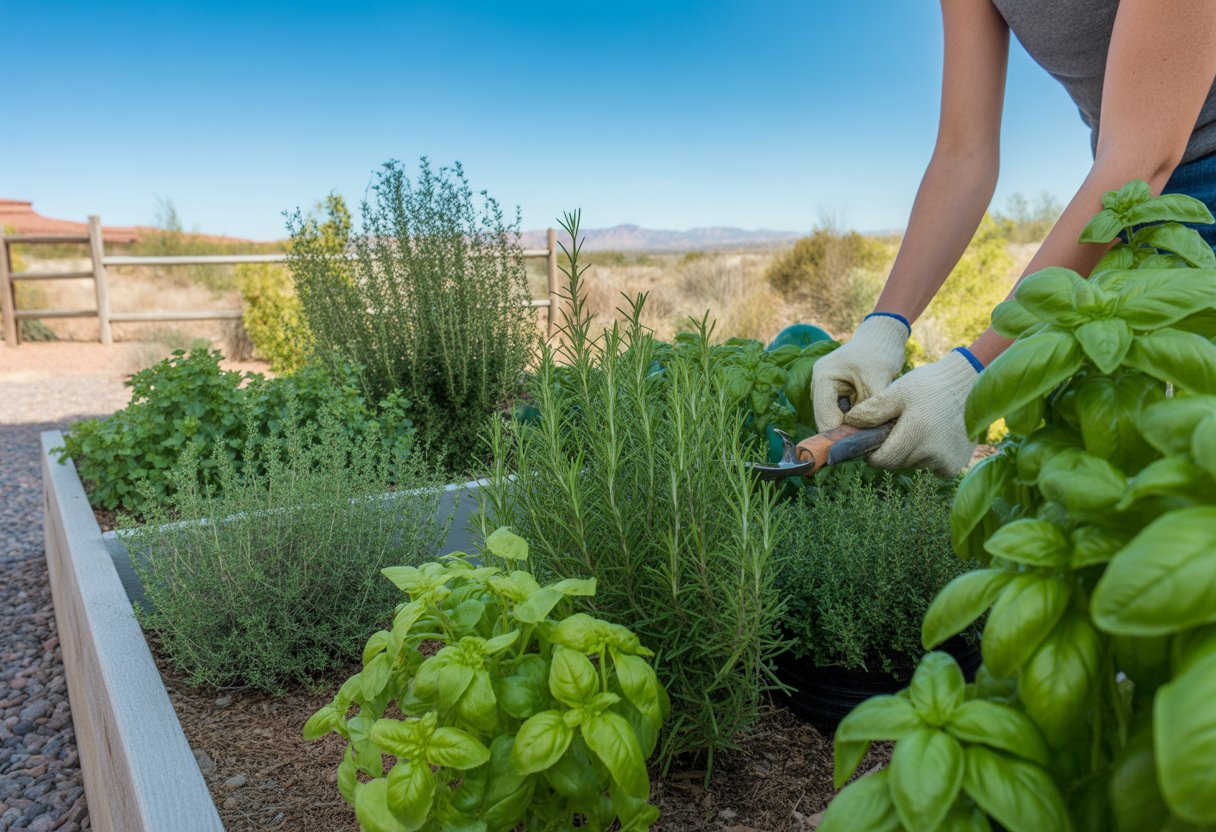
If you want herbs to thrive in Utah, go for drought-tolerant herbs, improve your soil drainage, and time your planting to dodge frost. That’s the core of it.
Even beginners can pull off a solid herb garden and enjoy fresh flavors all year—Utah’s landscape is challenging, but it’s not impossible.
Understanding Utah’s Unique Herb Gardening Climate
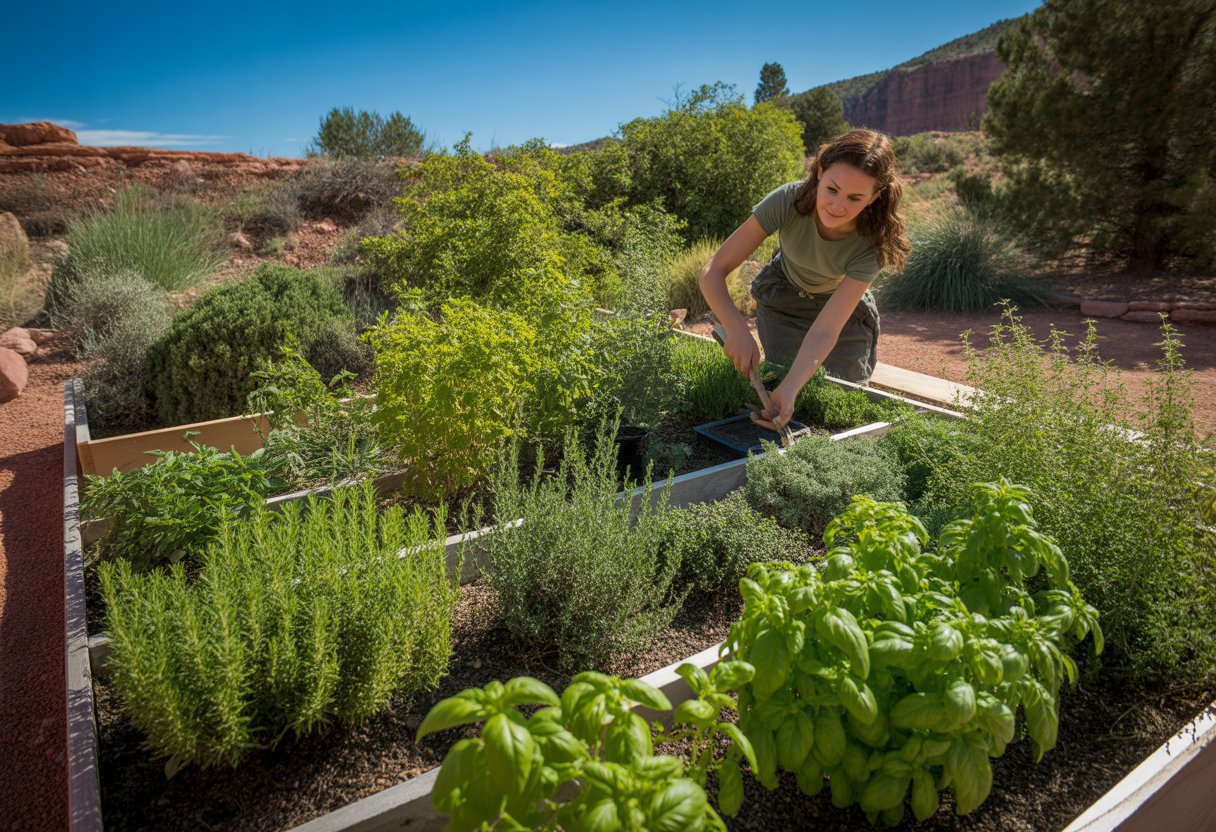
Utah’s climate is a patchwork of regions, elevations, and wild weather swings. You really have to pay attention to these details to pick the right herbs and nail down your care routine.
Regional Differences Within the State
Northern Utah, like Logan (zip code 84321), gets hammered by long, cold winters and a short growing season—about 120 days. Down south, St. George (zip code 84770) feels more like the desert, with over 300 frost-free days and a much longer window for growing.
The Wasatch Front, including Salt Lake City (zip code 84101), sits in a semi-arid zone with moderate temps. Rainfall averages 16 inches a year, so you’re working with dry air and not much moisture. Picking herbs that match your zone’s quirks is half the battle.
Impact of Elevation and Soil Conditions
Utah’s elevation is all over the map—from 2,000 feet in the southwest to over 13,000 in the mountains. Higher spots get cooler temps and shorter seasons, which can make some herbs struggle. Rosemary does well around 4,000 feet near Provo (zip code 84601), but above 7,000 feet? Not so much.
Soil here is usually alkaline and sandy, especially in low valleys. You’ll want to mix in organic matter to help the soil hold water and nutrients. Regularly testing soil pH keeps things on track. Basil and thyme like it slightly acidic to neutral.
Adapting to Utah’s Weather Extremes
Utah’s daily temps can swing 30°F or more, which is rough on plants. Frost can sneak up in spring and fall, so row covers or cold frames are a must for tender herbs.
With summer heat and low humidity, you’ll be watering and mulching more to keep soil from drying out. Wind is a pain, too—it dries out plants fast. Tucking herbs near fences or windbreaks helps a lot.
Utah gardeners have to stay on their toes—weather changes fast, and your herbs will let you know if you miss a beat.
Selecting and Planting Herbs for Utah Gardens
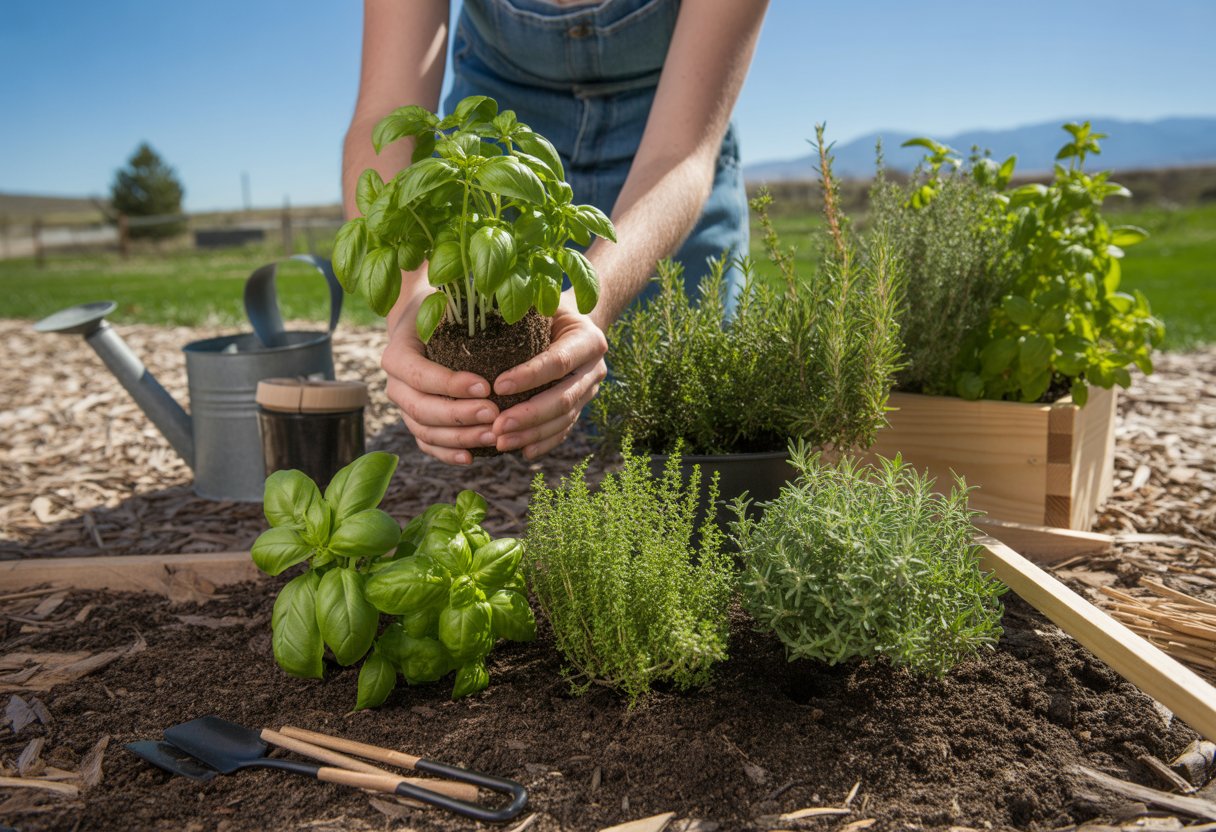
Picking the right herbs and knowing how to start them is key in Utah. Climate, soil, and the seasons all play a part, so it’s worth planning ahead.
Choosing the Best Herbs for Utah
Utah’s dry, sunny vibe is perfect for Mediterranean herbs—rosemary, thyme, oregano, and lavender love it here. They’re tough, handle heat, and don’t mind dry soil. Basil and cilantro want warm summers but can’t take a frost. Parsley and mint are fine with a bit of shade and more water.
Sage is a champ in Utah’s soil and doesn’t mind drought. It likes full sun but isn’t too picky. Mint spreads like crazy, so stick it in a pot or keep it contained. Native or climate-adapted herbs usually do best.
Starting Herbs from Seeds and Germination
Starting from seed? Watch your temps and moisture. Basil, parsley, and cilantro sprout best at 65-75°F and need steady, not soggy, moisture. Use a light, well-draining seed mix.
Oregano and thyme seeds like some light, so don’t bury them too deep. Rosemary takes its sweet time—sometimes three weeks to sprout. Soaking seeds for 12 hours before planting can help wake them up.
Transplanting Nursery Starts and Companion Planting
Move nursery starts outside after the last frost, when soil hits about 60°F. Harden off seedlings for a week or so, letting them get used to the outdoors slowly. Give rosemary and sage 18-24 inches of space; basil and parsley need at least 12-18 inches.
Companion planting can make your life easier. Basil near oregano and parsley can boost flavor and keep pests away. Mint should be kept separate so it doesn’t take over. Lavender, thyme, and rosemary play well together since they all like similar conditions.
Optimizing Growth and Care for Your Herb Garden
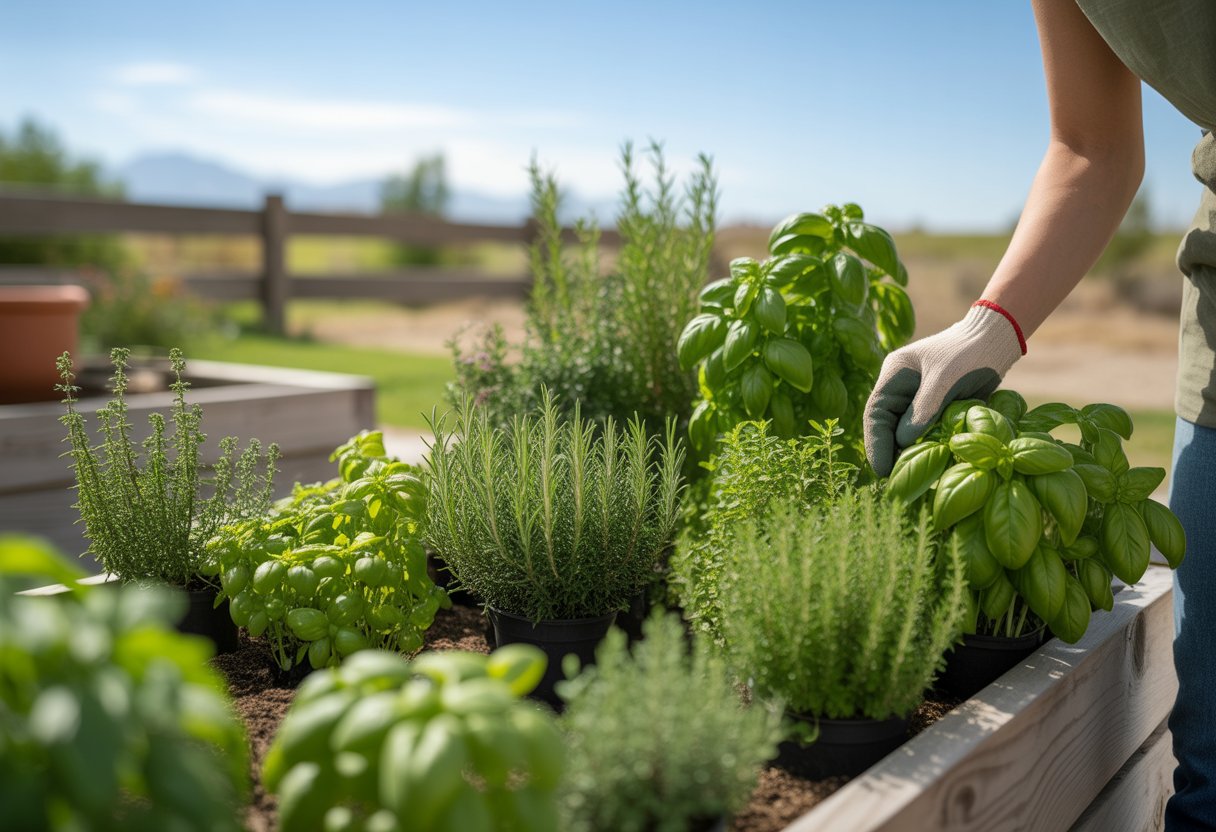
Herbs need regular attention—watering, good soil, pest control, and the right way to harvest. Getting these details right means bigger, tastier plants.
Irrigation and Water Conservation Techniques
Utah herb gardens do best with deep, not frequent, watering. This encourages roots to grow strong. Rosemary and lavender prefer things on the dry side, so don’t drown them. Parsley and mint are thirstier.
Drip irrigation or soaker hoses are great for saving water and getting it straight to the roots. Mulch with straw or wood chips to keep moisture in and slow down evaporation.
Water in the morning so leaves dry out and you avoid fungus. Stick your finger in the soil to check if it’s time to water—Utah summers can dry things out fast.
Organic Fertilization and Soil Improvement
Herbs love soil that drains well and is packed with organic matter. Mixing compost in before planting helps with both texture and nutrients—especially for basil, oregano, and sage.
A balanced organic fertilizer every month or so keeps growth steady. Skip the high-nitrogen stuff, or you’ll get lots of leaves but not much flavor. Aim for even parts nitrogen, phosphorus, and potassium.
Most herbs are happy with soil pH between 6.0 and 7.0. Test your soil once a year to catch any issues. Add lime or sulfur if you need to tweak the pH.
Disease Prevention and Pest Management
Good airflow is your friend—crowded herbs like oregano and thyme can get fungal diseases if things are too damp. Give them space and prune now and then.
Watch out for aphids, spider mites, and whiteflies. Insecticidal soap or neem oil works for organic pest control without killing the good bugs. Release ladybugs if you’re feeling fancy.
Check your herbs weekly for trouble. Take off sick leaves and clean your tools to stop diseases from spreading.
Pruning and Harvesting Guidelines
Pruning makes herbs bushier and more productive. Pinch basil and mint tips to get them to branch out. Snip off rosemary and sage flowers to keep flavor up and leaves coming.
Harvest in the morning after the dew dries for the best flavor. Use sharp, clean scissors so you don’t hurt the plant.
With perennials like lavender and thyme, don’t cut more than a third at a time. Regular picking keeps them healthy and productive through the season.
Extending the Utah Herb Gardening Season
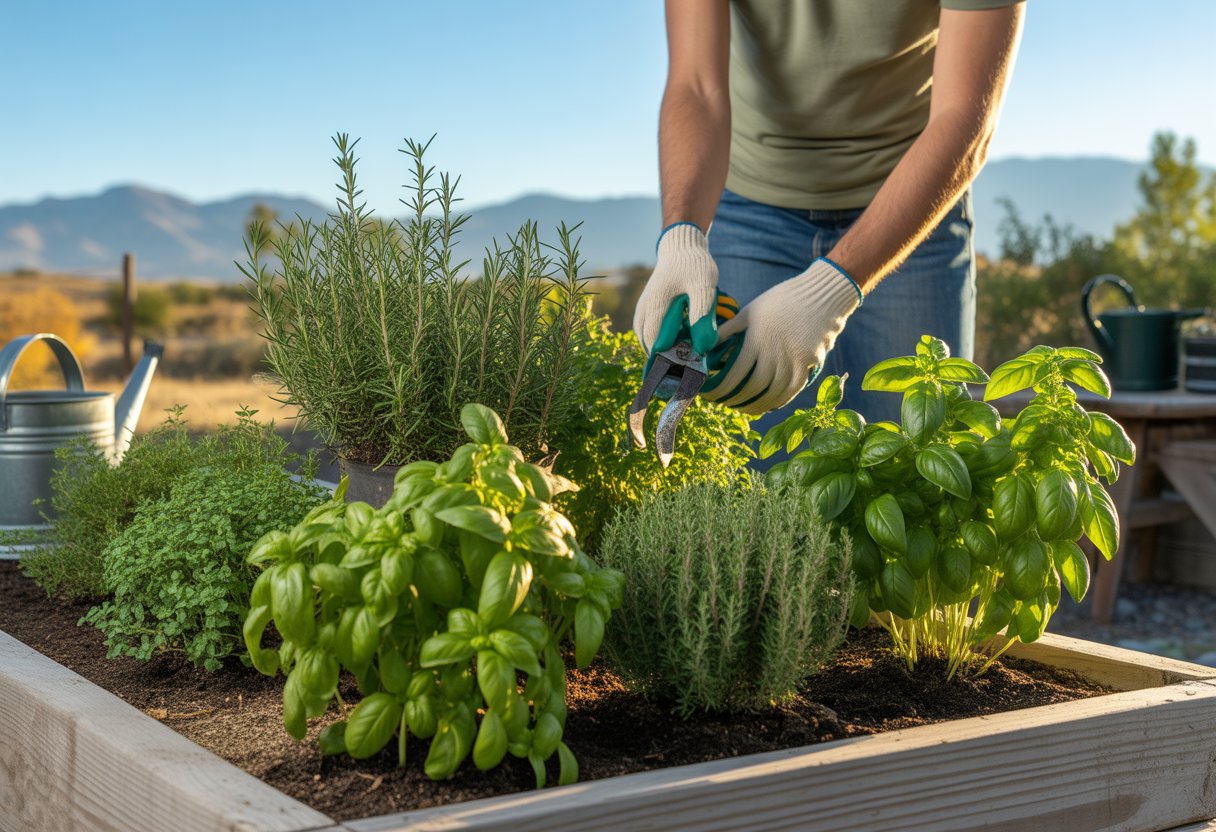
Utah’s got cold winters and a short growing season, so you’ll need a plan if you want herbs year-round. Protecting perennials, growing indoors, and preserving extras all help stretch your harvest.
Overwintering Perennial Herbs
Perennials like rosemary, sage, thyme, oregano, lavender, and mint can make it through Utah winters with a little help. Mulch around the base with straw or shredded leaves to insulate roots from freezing.
Rosemary and lavender do better in well-drained soil so roots don’t rot in winter. Give them a light pruning before it gets cold to reduce stress.
Some folks dig up rosemary or mint and stash them in pots in an unheated garage. It’s not a bad move for surviving those brutal cold snaps.
Using Containers and Indoor Growing
Containers let you grow basil, parsley, cilantro, and mint past what the weather allows outside. Indoors or in a greenhouse, you control the temperature and light.
Set pots in a bright south-facing window or under grow lights for 12-16 hours a day. Use well-draining soil and water regularly, but don’t let them sit in soggy dirt.
Containers are easy to move—put them outside when it’s warm, bring them in when it’s cold. That flexibility is a lifesaver in Utah’s unpredictable spring and fall.
Preserving and Storing Homegrown Herbs
Preserving herbs lets you enjoy them long after the growing season ends. Drying is a go-to for thyme, oregano, sage, and rosemary.
Just hang small bundles in a dark, breezy spot. Wait until the leaves feel crisp.
Freezing is another solid option, especially for basil, cilantro, and parsley. I like to chop the herbs, toss them into ice cube trays, and cover them with a splash of water or oil.
Pop the trays in the freezer, and you’ve got flavorful cubes ready for cooking. It’s surprisingly effective at keeping the taste fresh.
You can also stash herbs in the fridge. Wrap them in damp paper towels, tuck them inside a plastic bag, and they’ll stay good for about two weeks.
This trick works best for delicate herbs like cilantro and parsley.

